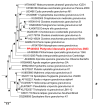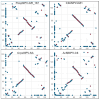The Genome Sequences of Baculoviruses from the Tufted Apple Bud Moth, Platynota idaeusalis, Reveal Recombination Between an Alphabaculovirus and a Betabaculovirus from the Same Host
- PMID: 40006957
- PMCID: PMC11861948
- DOI: 10.3390/v17020202
The Genome Sequences of Baculoviruses from the Tufted Apple Bud Moth, Platynota idaeusalis, Reveal Recombination Between an Alphabaculovirus and a Betabaculovirus from the Same Host
Abstract
The USDA-ARS collection of insect viruses at Beltsville, MD, USA, contains samples of an alphabaculovirus from larvae of the tufted apple bud moth, Platynota idaeusalis Walker, as well as a presumptive betabaculovirus from the same host species. The viruses in these samples-Platynota idaeusalis nucleopolyhedrovirus isolate 2680 (PlidNPV-2680) and Platynota idaeusalis granulovirus isolate 2683 (PlidGV-2683)-were characterized by electron microscopy of their occlusion bodies (OBs) and determination and analysis of their genome sequences. Scanning and transmission electron microscopy of the OBs revealed morphologies typical for alphabaculoviruses and betabaculoviruses. Sequencing viral DNA resulted in circular genomes of 121,881 bp and 106,633 bp for PlidNPV-2680 and PlidGV-2683, respectively. Similar numbers of ORFs (128 for PlidNPV-2680, 125 for PlidGV-2683) were annotated, along with ten homologous regions (hrs) in the PlidNPV-2680 genome and five intergenic regions of tandem direct repeats (drs) in the PlidGV genome. Phylogenetic inference from core gene alignments suggested that PlidMNPV-2680 represents a unique lineage within the genus Alphabaculovirus, while PlidGV-2683 was grouped with clade b betabaculoviruses. A comparison of the PlidNPV-2680 and PlidGV-2683 genomes revealed a 1516 bp region in PlidNPV-2680 that exhibited 97.5% sequence identity to a region of the PlidGV-2683 genome, suggesting that recombination had occurred recently between viruses from these lineages.
Keywords: Alphabaculovirus; Betabaculovirus; Platynota idaeusalis; baculovirus; genome; granulovirus; nucleopolyhedrovirus; occlusion bodies; recombination.
Conflict of interest statement
The authors declare no conflicts of interest. The mention of trade names or commercial products in this publication is solely for the purpose of providing specific information and does not imply recommendation or endorsement by the US Department of Agriculture. USDA is an equal opportunity provider and employer.
Figures







Similar articles
-
The complete genome sequence of a second alphabaculovirus from the true armyworm, Mythimna unipuncta: implications for baculovirus phylogeny and host specificity.Virus Genes. 2019 Feb;55(1):104-116. doi: 10.1007/s11262-018-1615-7. Epub 2018 Nov 14. Virus Genes. 2019. PMID: 30430308
-
The Operophtera brumata Nucleopolyhedrovirus (OpbuNPV) Represents an Early, Divergent Lineage within Genus Alphabaculovirus.Viruses. 2017 Oct 21;9(10):307. doi: 10.3390/v9100307. Viruses. 2017. PMID: 29065456 Free PMC article.
-
Genome of Cnaphalocrocis medinalis Granulovirus, the First Crambidae-Infecting Betabaculovirus Isolated from Rice Leaffolder to Sequenced.PLoS One. 2016 Feb 5;11(2):e0147882. doi: 10.1371/journal.pone.0147882. eCollection 2016. PLoS One. 2016. PMID: 26848752 Free PMC article.
-
Intravenous magnesium sulphate and sotalol for prevention of atrial fibrillation after coronary artery bypass surgery: a systematic review and economic evaluation.Health Technol Assess. 2008 Jun;12(28):iii-iv, ix-95. doi: 10.3310/hta12280. Health Technol Assess. 2008. PMID: 18547499
-
Systematic review and economic analysis of the comparative effectiveness of different inhaled corticosteroids and their usage with long-acting beta2 agonists for the treatment of chronic asthma in adults and children aged 12 years and over.Health Technol Assess. 2008 May;12(19):iii-iv, 1-360. doi: 10.3310/hta12190. Health Technol Assess. 2008. PMID: 18485271
References
-
- Harrison R.L., Hoover K. Baculoviruses and other occluded insect viruses. In: Vega F.E., Kaya H.K., editors. Insect Pathology. 2nd ed. Academic Press; Boston, MA, USA: 2012. pp. 73–131.
-
- Rohrmann G.F. Baculovirus Molecular Biology. National Center for Biotechnology Information; Bethesda, MD, USA: 2019. - PubMed
-
- Landwehr A. Benefits of baculovirus use in IPM strategies for open field and protected vegetables. Front. Sustain. Food Syst. 2021;4:593796. doi: 10.3389/fsufs.2020.593796. - DOI
MeSH terms
Substances
Associated data
- BioProject/PRJNA1150071
- Actions
- Actions
LinkOut - more resources
Full Text Sources

